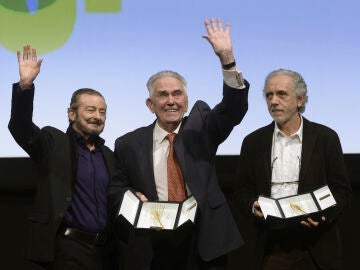
The director of photography, film restorer and researcher Juan Mariné (1920, Barcelona) you will receive the Goya of Honor 2024, the highest recognition of the Film Academy, as reported this Friday by the institution. The Board of Directors of the Film Academy has decided give you this award “for your entire dedication to cinema for more than 80 years of trajectory that go through the history of Spanish cinema, for their efforts in the work of film conservation and restoration, and for vividly representing, through their craft, the importance of light in the history” of Spanish cinema.
Recognized with the National Cinematography Award, the Gold Medal of Fine Arts, the National Photography Award, the Second Chomón Award, the Spike of Honor from the Seminci of Valladolid, the Juan de la Cierva Research Award and the Medal of the Academy, among other awards, Mariné He started working in the seventh art when he was 14 years old.. “Unconditional of the activities carried out by the Film Academy – he was the first director of photography to join the institution – this explorer of the image collaborated with filmmakers such as Edgar Neville, José Luis Sáenz de Heredia, Antonio del Amo, José María Forqué, Pedro Lazaga and Pedro Masó in the more than 150 films he photographed – the last one was ‘La grieta’, by Juan Piquer Simón -“, recalls the Academy.
As they emphasize, “talking about this veteran professional who for years worked in restoration at the Spanish Film Archive and that he has researched and invented techniques with which to improve the quality of the image is to trace the history of our cinema.” Born on the last day of 1920 in Barcelona, he was 13 years old when he arrived at the Orphea studios in Barcelona, where ‘The Eighth Commandment’ was being filmed, to deliver some new cameras that came from France. The cameras were not working and he, thanks to his knowledge of French, plugged them in correctly and began to take care of them.
Affiliated with the CNT union, Mariné recorded the burial of Buenaventura Durruti, murdered in November 1936, a funeral that was filmed by hand because the camera batteries ran out; He was a war photographer for Enrique Líster; was interned in French concentration camps of Saint-Ciprien and Argelès-sur-Mer; He traveled as a prisoner from San Sebastián to Cádiz; He entered the La Rinconada prison camp (Seville), from where he left thanks to his father’s contacts; and he was a photographer for the General Staff of Catalonia, a position he combined with jobs as a photography assistant in productions filmed in Barcelona.
Once freed and the war over, he went to the cinema again to see the American film ‘The Great Ziegfeld’, a screening that had an impact on him and for which he promised himself that he would dedicate his life to cinema, as the Academy recalls, more of eighty years of experience that go through the history of Spanish cinema, his efforts in the work of conservation and restoration and for vividly representing, through his craft, the importance of light in the history of our cinema” that defines Mariné as “one of the most important, innovative and longest-lived directors of photography in the history of Spain.”
Mariné, behind the first color film
He debuted as a director of photography in ‘Cuatro mujeres’, by Antonio del Amo; He worked under numerous filmmakers; and he participated in co-productions, but he was never attracted to Hollywood (Orson Welles invited him to come and stay at his house when he went to teach at the University of California in Los Angeles). Decade by decade, he added titles, among which includes the first color film in the history of Spain, ‘The cat’. He was the inventor of new photographic and film restoration techniques, such as an optical copier or a negative washing machine designed by himself, which he put into practice at the Filmoteca Española (which in 2020 honored him with the screening of films both photographed and restored by him, such as ‘Orgullo’, ‘La gata’, ‘La gran familia’, ‘Supersonic Man’, ‘Currito de la Cruz’ and ‘La pueblo sangre’, among others) and where he rescued Spanish productions that were considered unrecoverable.
When he left photography direction in 1990, was director of cinematography restoration at the ECAM (Film School of the Community of Madrid), where he attended daily until 2020, the year the pandemic arrived. In the basement of the school he had his office (several rooms full of machines and film material), the ‘sub-Mariné’, in the words of the center’s students, where he investigated, cleaned and restored the celluloid.
The subject of several documentaries, the premiere of ‘Juan Marine. A century of cinema, a documentary film written and directed by María Luisa Pujol endorsed by the Josep M. Queraltó Collection Aula de Cine Foundation, of which Mariné is one of its Honorary Patrons. The Film Academy has honored Juan Mariné on several occasions, most recently last July when ‘Juan Mariné: between light and shadow’ was screened, a documentary by Rafael Toba in which Mariné says goodbye with a declaration of love for cinema. : “I have always thought that we are here for something in the world. I can’t stop shooting movies.”
Source: Lasexta
Bruce is a talented author and journalist with a passion for entertainment . He currently works as a writer at the 247 News Agency, where he has established himself as a respected voice in the industry.












